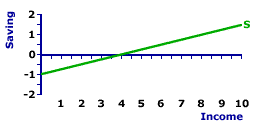
|
|
PERSONAL INCOME AND NATIONAL INCOME: Personal income (PI) is the total income received by the members of the domestic household sector, which may or may not be earned from productive activities during a given period of time. National income (NI) is the total income earned by the citizens of the national economy resulting from their ownership of resources used in the production, which may or may not be received by members of the household sector. Personal income can be derived from national income by subtracting income earned but not received (IEBNR) and adding income received but not earned (IRBNE).
Visit the GLOSS*arama
|
|


|

|
                           SLOPE, SAVING LINE: The positive slope of the saving line is also termed the marginal propensity to save (MPS). This slope is greater than zero but less than one, reflecting induced saving and the Keynesian psychological law of consumer behavior that saving increases by less than the increase in income. The slope of the saving line provides the foundation for the slope of the leakages line used in the injections-leakages model. It thus also affects the magnitude of the multiplier process. | Saving Line | 
|
The saving line, also termed propensity-to-save line or saving function, shows the relation between saving and income for the household sector. The income measure commonly used is national income or disposable income. Occasionally a measure of aggregate production, such as gross domestic product, is used instead.A representative saving line is presented in the exhibit to the right. This green line, labeled S in the exhibit, is positively sloped, indicating that greater levels of income generate greater saving by the household sector. This positive relation corresponds to the fundamental psychological law of Keynesian economics. The saving line graphically illustrates the saving-income relation for the household sector, which is the foundation of the leakages line used in Keynesian economics to identify equilibrium income and production. The slope of the saving line presented here is positive, but less than one. In fact, the slope of the saving line is numerically equal to the marginal propensity to save. In this case the slope is equal to 0.25. The positive slope reflects induced saving--more income means more saving. It also reflects the basic Keynesian psychological law. Click the [Slope] button to illustrate. To illustrate the equality between slope and the marginal propensity to save, consider the equations for each. The slope of the saving line is specified as the "rise" over the "run." The rise is the change in saving measured on the vertical axis and the run is the change in income measured on the horizontal axis. | slope | = | rise
run | = | change in saving
change in income |
The marginal propensity to save (MPS) is the incremental change in saving resulting from an incremental change in income. | MPS | = | change in saving
change in income |
The slope of the saving line is the marginal propensity to save, they are one and the same.The positive slope of the saving line reflects induced saving, which is saving that depends on the level of household sector income. If the household sector receives more income, then it is induced to undertake additional saving. Of course, a drop in income induces the household sector to reduce saving.

Recommended Citation:SLOPE, SAVING LINE, AmosWEB Encyclonomic WEB*pedia, http://www.AmosWEB.com, AmosWEB LLC, 2000-2024. [Accessed: May 12, 2024].
Check Out These Related Terms... | | | | | | | | | | | | | | |
Or For A Little Background... | | | | | | | | | |
And For Further Study... | | | | | | | | | | | | | | | |
Search Again?
Back to the WEB*pedia
|



|

|
|
A communal society, a prime component of Karl Marx's communist philosophy, was advocated by the Greek philosophy Plato.
|

|
|
"The tragedy of life is not so much what men suffer, but rather what they miss. " -- Thomas Carlyle, Historian
|

|
ATC
Average Total Cost
|

|
|
Tell us what you think about AmosWEB. Like what you see? Have suggestions for improvements? Let us know. Click the User Feedback link.
User Feedback
|


|


